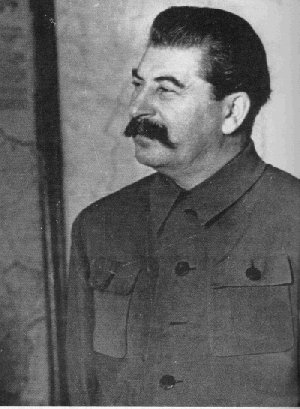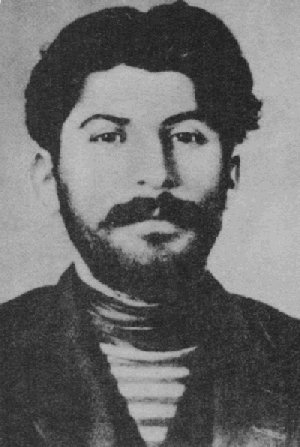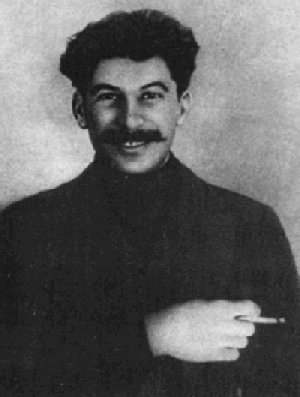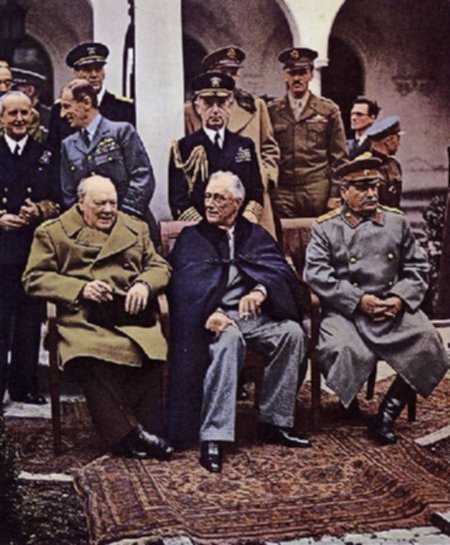by Bryan Pavlovic

Portrait of Stalin
After the death of Lenin in 1924, Joseph Stalin ruled the Soviet Union with an iron fist for 24 years. Stalin rarely appeared to be what he really was and consistently was underestimated by his opponents. Stalin pushed the Solviet Union into world power, but with this power he forced his nation upon one of the most ruthless reigns in history.
He was born
as Joseph Vissarionovich Djugashvili on December 21, 1879, in the Georgian hill town of Gori. His father was a very poor and very unsuccessful shoemaker. He was an alcoholic and constantly beat his son. His father died in a fight when Stalin was 11 years old. Ekaterina, Stalin's mother, was a washer woman who hoped her son would grow up to be a priest. Although his parents spoke no Russian, he was forced to learn it because it was the language taught at the Gori Church School that he attended. Stalin was the best pupil in his school and at the age of 14 he earned a full scholarship to the Tbilisi Theological Seminary. During the year of 1898, he became involved in radical political activity. The following year he left the Tbilisi Theological Seminary without graduating and became a full-time revolutionary organizer. By 1901, Stalin became a member of the Georgian branch of the Social Democratic Party. Stalin was always helping with strikes, and spreading socialist literature. Stalin did not have a strong voice or charisma, but had a practical talent at organizing activities.

Stalin soon after joining Bolsheviks
The Social Democrats split into two groups in 1903, the Bolsheviks and Mensheviks. Stalin joined the more drastic Bolsheviks. Their leader Vladimir Ilich Lenin liked Stalin's practical understanding of Russian nationality problems. During this period of time, Stalin was arrested repeatedly, but escaped imprisonment most of the time. But in 1902, after being arrested in Batum and he spent more than a year in prison before being exiled to Siberia. Between 1902 and 1913 Stalin was arrested eight times, exiled seven times, and escaped six times. Stalin's last exile in 1913 lasted until 1917, when he returned just after the Russian Revolution had overthrown the Czar's government.

Stalin as Leader of Bolsheviks
In 1912, Stalin's loyalty to Lenin paid off when Lenin appointed him to the Bolshevik Central Committee. Stalin gained respect and power among the Bolsheviks. He soon began to use the name Stalin, which means, "Man of Steel."
When
the threat of being arrested forced Lenin into hiding. Stalin assumed
leadership of the Bolsheviks. When Lenin returned in 1917 to
mastermind the overthrown of the weak Korinski government that had
replaced the monarchy, Stalin became one of Lenin's trusted
lieutenants. After the Bolsheviks seized power Stalin was given great power in the new Communist government of the USSR. Stalin was soon able to control appointments, set agendas, and transfer thousands of party officials from post to post at will. Stalin soon formed a hatred for people he felt were smarter than him. After Lenin's death in 1924, Stalin began to gain more and more power, and by the end of 1929, Stalin was the absolute ruler of the USSR.
Stalin
feeling like he had risen to the very top decided to crush those who
appeared to have doubted his wisdom and ability. In the mid-1930s Stalin launched a major campaign of political terror. No one was safe from the arrests and deportations to labor camps. Former rivals Zinovyev, Kamenev, and Bukharin admitted to "crimes against the state" in show trials and were sentenced to death.

Symbol Of The USSR
In 1939, just prior to World War II, Stalin, who feared the power of Nazi Germany, signed an non-aggression treaty with Hitler. But, the Treaty lasted only two years, when the Germans broke it and invaded the Soviet Union in 1941. Of course, this angered Stalin, and he decided to wage his own war on Nazi Germany, he rallied his people against Germany, and started forcing the Germans out after the Battle of Stalingrad in 1943. Soon Russian troops were invading Germany. At the end of the war, he forced communism on the countries occupied by his troops.

Stalin, FDR, and Churchill at the Yalta conference During World War II
Between 1944 and 1952 Stalin was involved with an economic and ideological struggle with the Western nations called the "Cold War." He cut the Solviet Union off from as much contact with the "capitalistic West" as he could and hid behind what became known as "The Iron Curtain." The struggle included confrontations such as the Berlin Blockade and the Korean War. Stalin's paranoia became Solviet policy.
In early 1953, Stalin once again apparently started another one of his political "cleansing" campaigns. He started with the arrest of many Moscow doctors who he charged with "medical assassinations." But, before this campaign got off the ground, Stalin died suddenly on March 5, 1953. Naturally, with Stalin's death, his reputation took a steep dive when his successors began exposing his crimes.
Rosenberg, William G. "Joseph Stalin" Grolier 1998 Interactive Encyclopedia, 05/23/00
" Stalin's 5 year plan" @ http://members.aol.com/marcin23/5yearplan.htm 05/22/00
"Communism Online" @ http://www.cyberenet.net/~lking/stal.htm 05/22/00
"Marxism and the national question" @ http://www.marxists.org/reference/archive/stalin/works/1913/03.htm , online, 05/22/00
Picture #1 - "Portrait of Stalin" From: http://www.marxists.org/reference/archive/stalin/photo/s1936a.htm
Picture #2 - "Stalin after Joining Bolsheviks" From: http://www.marxists.org/reference/archive/stalin/photo/s1912a.htm
Picture #3 - "Stalin as Leader of Bolsheviks" From: http://www.marxists.org/reference/archive/stalin/photo/s1915a.htm
Picture #4 - "Symbol Of The USSR" From: http://members.aol.com/redtsar/index.html
Picture #5 - "Stalin, FDR and Churchill at the Yalta conference during WWII: From: http://www.earthstation1.com/2ndWWPics/BigThreeColorYalta4502.jpg